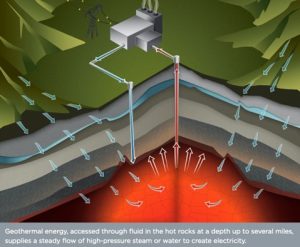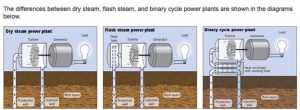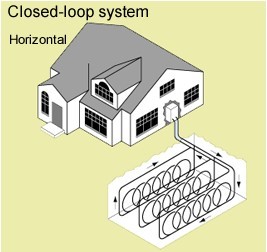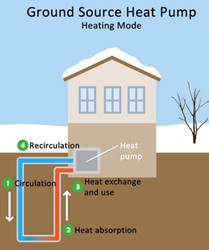TECHNOLOGIES
How Geothermal Works
Geothermal energy is based on hydrothermal resources beneath the earth’s surface. Heat from the Earth’s core is constantly flowing outward towards the surface, but, with the exception of lava or hot springs and geysers, that heat usually remains below the surface, heating rocks and water nearby, sometimes as hot as 700ºF. The hot water or steam can become trapped in permeable and porous rocks under layers of impermeable rock, which forms geothermal reservoirs, referred to as either dry steam wells or water wells.[1]

Source: Department of Energy[2]
Technologies Currently in Place for Tapping Geothermal Energy
There are a number of ways to tap into geothermal energy, for either space heating and cooling (and hot water heating), or as a means to produce electricity.
Geothermal Power Plants Produce Electricity
At geothermal power plants, subsurface hydrothermal resources with temperatures from 300ºF to 700ºF are tapped by drilling wells to bring the steam or water to the surface, where it powers a turbine that generates electricity. Modern closed-loop geothermal power plants emit no greenhouse gasses and consume less water on average over the lifetime energy output than the most conventional generation technologies.[3]
There are three basic types of geothermal power plants:
- Dry steam plants use steam directly from a steam reservoir to turn generator turbines.
- Flash steam plants take hot water from deep below the surface and convert it to steam to drive turbines. When the steam cools, it condenses to water and is injected back into the ground to be used again. Most geothermal power plants are flash steam plants.
- Binary cycle power plants transfer the heat from geothermal hot water to another liquid, in a heat exchanger, where the heat causes the second liquid (with a much lower boiling point) to turn to steam, which is used to drive a turbine.[4]

Source: U.S. Department of Energy (public domain)[5]
In addition to generating electricity at geothermal power plants, deep geothermal sources can provide efficient, clean heat for industrial processes and some large-scale commercial and agricultural uses.[6]
Geothermal Heat Pumps Heat and Cool Buildings
According to the U.S. Environmental Protection Agency (EPA), geothermal heat pumps are the most energy-efficient, environmentally clean, and cost-effective systems for heating and cooling buildings. Unlike varying surface air temperatures, the earth’s temperature 10 feet below ground is consistently between 50°F and 60°F. For most areas of the U.S., this means soil temperatures are usually warmer than the air in winter and cooler than the air in summer. Geothermal heat pumps use the earth's constant temperature to transfer heat from the ground (or water) into buildings during the winter and reverse the process in the summer.[7]


Source: U.S. DOE [8] Source: U.S. EPA [9]
Ground Source heat pumps are connected to a series of buried pipes installed either in horizontal trenches just below the ground surface or in vertical boreholes that go several hundred feet below ground. The heat pump circulates a fluid, sometimes water, through the pipes to move heat from point to point. In winter, as the fluid passes through the ground loop, it absorbs heat from the warmer soil, rock, or ground water and then returns to the building where the system uses a heat exchanger to transfer heat into the building’s existing air handling system. In summer, the fluid absorbs heat from the air inside the building through the heat exchanger and is then cooled by the colder subsurface soil, rock, or ground water. Ground source heat pump systems can support space heating and cooling needs in almost any part of the country, as well as hot water heating.[10]
Direct Use Geothermal
Direct use geothermal takes advantage of hot water that may be just a few feet below the surface, and usually less than a mile deep. The capital costs are relatively small compared with deeper geothermal systems, but these systems are currently limited to regions with naturally high geothermal activity - such as Yellowstone National Park and Iceland, where water as hot as 200°F or more can be accessed at the surface or pumped directly from underground. This water is hot enough for large-scale pool heating; space heating, cooling, on-demand hot water, district heating, heating roads and sidewalks to melt snow, and some industrial and agricultural processes.[11]
Updated June 2022 by Diane M Long

Comments are closed.